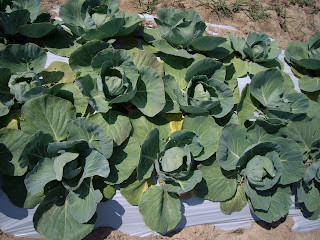
(Here is a photo of Nathaniel running off with the fall cover crops. Part of his parole package (for boosting pumpkins) included seeding the cover crops. So much for The System ... We started with 70% Winter Rye, 25% Hairy Vetch and 5% Tillage Radish seed).
Notice the twine along the edges of the field.
Prior to cover crop emergence, geese lazily wander across plowed / seeded fields in search of greens on the other side. Thousands of little footsteps compact the soil surface thus reducing and delaying, if not completely eliminating, seedling emergence.
After emergence, geese merrily chomp the tender seedlings. Hundreds of geese can clear cut a field in a matter of hours.
Baah! Geese are such a threat to establishing a healthy cover crop. The solution? Exploit the laziness. Suspend a single strand of twine 8" above the soil.
This year the goose fence includes two improvements. Breakaway twine and tensioners.
Deer frequently wander through the fields. White nylon twine has the highest visibility (as opposed to natural sissal twine) but deer still occasionally snap the twine. I attach the twine to the wooden post with a horizontal nail. In the past, I would loop the twine around the nail. Now, on certain posts, I simply lay the twine on the nail. After monitoring the deers' traffic patterns, I strategically loop some posts and, in the high traffic areas, lay the other posts. The result is the twine falls off the post instead of snapping.
The other improvement is tensioners. Throughout the winter the twine tends to stretch and sag. Adding a second nail to the wrapped line posts allows me to wind the twine between the two nails effectively eliminating sag.
These two improvements allow me to maintain a twine line literally with one hand. Cutting, splicing and tying elaborate knots is fun, however, maintaining a twine line in less than 60 seconds is a lot more fun.








































